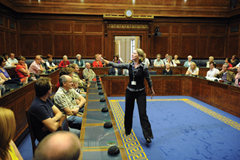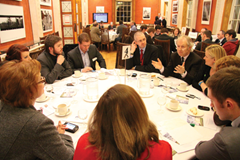Assembly engagement
 Falling turnout suggests a growing gap between the Assembly and those it represents. Director of Information and Outreach Gareth McGrath updated an agendaNi seminar on how Stormont is connecting with the public.
Falling turnout suggests a growing gap between the Assembly and those it represents. Director of Information and Outreach Gareth McGrath updated an agendaNi seminar on how Stormont is connecting with the public.
Consecutive falls in the Assembly’s turnout demonstrate rising apathy towards Stormont among the public. The turnout in May’s Assembly poll stood at 55.6 per cent, having fallen from 70 per cent in 1998. A month later, the West Belfast by-election had a record low turnout of 37.5 per cent i.e. less than two out of five potential voters taking part.
Speaking at an agendaNi seminar on the new Assembly, its Director of Engagement Gareth McGrath said optimists and pessimists could come to two different conclusions.
The “glass half full” view says that voters are generally content with the province’s relative stability. Alternatively, the “glass half empty” attitude sees the same voters as disenfranchised with politics in Northern Ireland.
Falling Assembly turnout cannot be seen in isolation. The same trend is seen in elections to Parliament, at UK and Northern Ireland levels, since 1997. “Declining electoral turnout,” he noted, “is a function of mature Western democracies.”
Civic participation (i.e. people seeking to influence the decisions that affect them) is one of the key phrases in this work. McGrath explained that several groups have been blamed for low levels of this, including politicians themselves, the Civil Service, society in general and the media. A co-ordinated effort is needed to change this trend.
Stormont is often wrongly reported. A headline about consultancy fees, for example, referred to the Assembly when the Executive was actually responsible. Journalists, in his view, had to up their game and were “still in the 70s and the 80s and the early 90s.” The media, he commented, loved a crisis rather than analysing detailed policy issues.
The five-party Assembly Commission, which oversees its administration, has a vision of “an Assembly that strengthens democracy and engages the people in creating a better future for all.” As an employee of the Assembly Commission, McGrath is not a civil servant.
On the ground, people had a “unique opportunity” to lobby MLAs. Almost everyone either knows an MLA personally or someone who knows one. Furthermore, people can write to committees, give evidence and send in their views to public consultations.
However, there is not a level playing field. The more educated and better off tend to engage more with the Assembly. People on lower incomes, young people (aged 16-34) and women were the most disengaged groups.
Information
The Assembly’s approach is three-fold: information, consultation and participation.
Research indicates that the traditional media are the most popular ways for getting information about the Assembly. An Ipsos MORI poll, conducted in late 2009 and early 2010, asked adults about their sources of information.
Thirty-nine per cent regularly used TV coverage. The figures for local newspapers and the radio were 22 per cent and 21 per cent respectively. Just 8 per cent regularly used the internet for that purpose.
BBC Northern Ireland’s Stormont Today, UTV Live and the BBC’s Democracy Live website provide dedicated coverage. The ‘House of the Hill’ documentary on BBC1 also showed viewers inside Parliament Buildings. Concerts on the premises also raise the Assembly’s profile.
Social media channels are well developed. A refreshed Assembly website is on the way in September as well as a new education site.
The Assembly’s research publications are also available online, alongside the updated register of members’ interests and detailed expenses. David Cameron’s visit in June, for example, cost £762.42.
The consultation part involves organising events where groups can learn more about the Assembly’s work. The Assembly roadshow series is one example, as is the proposed Youth Assembly.
Around 4,000 people attended community outreach events in 2010, including talks and seminars for community groups and a stand at the Balmoral Show.
The Northern Ireland Assembly and Business Trust (established in 2002) has almost 90 members and helps the two sectors understand each other better.
Parliament Buildings was open for free public tours over the summer recess. Over 23,000 people received a tour in 2010 and 35,000 people attended functions; both were increases on the previous year.
McGrath puts a high importance on international delegations visiting Stormont, as this allows Northern Ireland to give something back to the rest of the world. These have included visitors from troubled regions (e.g. Nepal, the Basque Country and the Middle East) and settled democracies such as Canada and the USA.
Participation
Finally, the public can participate in the Assembly’s work. Committees regularly ask for evidence and now organise seminars, workshops and ‘speed dating’.
This could also take place through ‘legislative consultation’. The White House has an online form where citizens can comment on legislation received by the President.
A more comprehensive example comes from Iceland where the constitution is being revised. The draft document is available online and the public can ‘sit in’ on Constitutional Council meetings via live broadcasts on the web. Discussions take place mainly through facebook but also through YouTube, flickr and twitter.
Closer to home, the Assembly was the first UK legislature to host a ‘tweet-up’ (a gathering of twitter users) in March. Twitter is also used to communicate what is happening in the chamber. Separately, the Executive Information Service used twitter to give a running commentary on the d’Hondt selections. Technology is “potentially transformational” but it’s important not to forget about the traditional media which remain popular.
Increasing turnout is not one of McGrath’s key performance indicators; indeed, there would be no way of proving a link between that and the engagement work. He will be content if the public is less cynical about politics and values the Assembly more by May 2015, when its next election is due.






